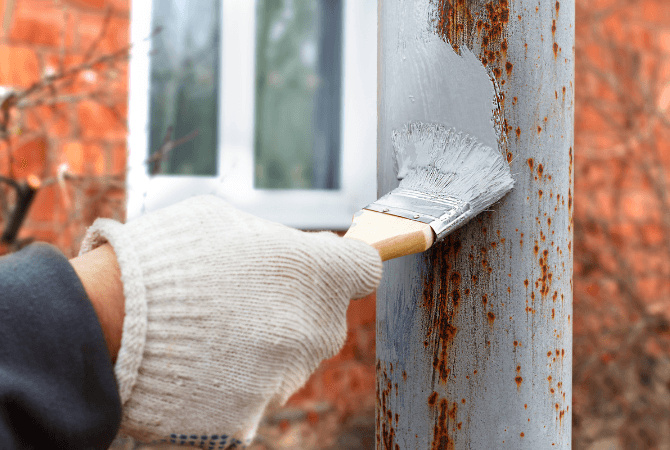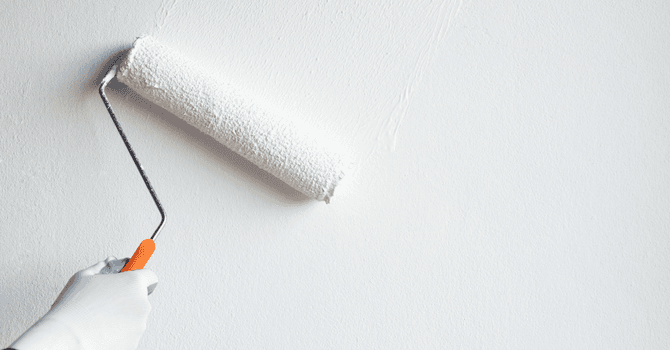
Rust is a dreadful problem that affects the service life of all metal items found in your home (steel, iron, etc.).
Believe it or not, a 2021 study showed that corrosion costs Canadian taxpayers 63 billion dollars annually. This is most likely a direct result of people erroneously thinking that oil-based paints are rust paints. Oil-based paints aren’t rust paints. In fact, most oil-based paints are decorative paints that only partially protect metal surfaces against atmospheric corrosion, however, can’t withstand general corrosion, which is brought on by gas and chemical products.
As for rust paints, these are made to protect metal components from degradation caused by humidity, salt spray, oxidation, or exposure to various environmental or industrial chemical products. In this article, you’ll find all there’s to know about rust paint, more specifically the advantages of using such paint, health and safety protocols, characteristics, and much more. Make sure to read to the very end to not miss out on anything!
Characteristics of Rust Paint

Source: Canva
There are four main types of rust paints sold market-wide. However, each has its own composition and paint-specific application process, which we’ll detail below.
Alkyd paint
This type of paint often contains organic solvents that give it a fighting chance against rust. This type of paint is especially practical to withstand humidity and ambient air and is often used to paint inside moisture-prone areas like the kitchen and bathroom. As opposed to water-based paint, which dries through water evaporation, the latter dries once the organic solvents found in its composition have evaporated and its binder has oxidized. Also, applying this type of paint doesn’t require any kind of prep since the level of difficulty entirely depends on the coarseness of the surface to be painted.
Epoxy paint
Epoxy paint, which was first designed for industrial use, is also known as a solvent-based epoxy coating. It can be applied to indoor and outdoor surfaces, but its most often used as a practical interior floor coating. Once applied, a painted surface becomes extremely durable and resistant (pool paint), while also giving off a nice finish and providing an area that’s wear-resistant that can also withstand heavy traffic and ill use. Not only does the coat of paint wear off slowly, but it also withstands grease stains, heat, rust, and oil, acid and diesel spills.
Rust paint
Rust paints are essentially made with citric acid, metal chloride, and a film-forming agent. You can also apply high-end paint directly on rust, which will effectively prevent any damage from spreading. However, when dealing with certain types of damages, you’ll need to use a rust converter prior to painting, as well as when preparing for any complex work.
Rust paints must have fast drying and curing properties. They can withstand abrasions and are rust-preventative, water and shock-resistant. In truth, this type of paint has an affordable and durable anti-corrosion coating.
Polyurethane paint
Polyurethane paint is made with natural molecules known as monomers. It’s derived from the word “polymer,” which is a long chain made up of repeating monomers. This type of paint serves as a material’s protective shield against various evils like corrosion, bad weather, abrasions, and other breakdowns.
In fact, polyurethane finishes combined with epoxy primers basically create a smooth, protective barrier on all surfaces on which it’s applied. This barrier is practically inscrutable to atmospheric elements like humidity, salts, and UV rays, meaning it pushes away weather factors from the material it’s coating to then provide corrosion-proof protection.
Benefits of Rust Paint

Source: Canva
Rust paints prevent or cut off corrosion by limiting the amount of water and air directly coming into contact with metal. They offer additional protection to metal surfaces and act as a barrier against chemical compounds or corrosive materials. More so, since this type of paint can be applied directly to rust, say goodbye to the rust-removal step. Listed below are the additional benefits you should know about rust paints:
Indoor and outdoor use;
Easy and simple to apply, for the general public;
Long-lasting protection, at least 10 years;
Extends service life of rust-prone metals so that they don’t need to be replaced after a few years;
Used in the construction industry and in households;
Wide array of colours;
Packaging adapted to all needs;
Resistant to numerous stresses (scratches and impacts);
Rust paints are typically relatively robust and high-end. Therefore, they’re used in areas where reliability is a priority.
Different Ways to Use Rust Paint
Areas to apply rust paints are incredibly vast. Rust paint is used everywhere on rust-prone items. It’s especially appreciated in the building sector and the automotive industry since a single coat is enough to protect the material in a reliable way, and thus to work in a cost-effective manner.
For the general public, rust paint is also perfect to fix minor damage. As such, metal items found outdoors, like handrails, are protected effectively from damage, in the long term. Rust paint is also widely used when transporting hazardous materials and in shipping.
Rust Paint Safety Measures
When working with rust paint, workplace safety has to come first. Rust paint contains various ingredients that can be harmful to human beings and animals. Look over the manufacturer’s data sheet prior to applying the product. Here are additional important safety measures:
Wear plastic or leather gloves to protect your skin while sanding or scraping.
Wear protective goggles and a disposable mask to maintain healthy lungs.
Wear hearing protection devices if your painting equipment is loud.
Don’t mix paint with food, drinks, or cigarettes.
Keep kids and pets away from the painting areas and equipment.
Don’t stir rust paints with a wooden stick.
Keep paint zones away from sources of heat.
Clean all the dust, grease, and grime. If you spot signs of rust, remove it with sandpaper or a metal wire brush.
Ensure that your workspace is adequately ventilated. This also applies during the paint drying phase. If possible, work outdoors.
Rust Paint Price Point

Source: Canva
When it comes to rust paint, it’s important to know the price point and characteristics of the product prior to purchasing it. So, to give you a good idea of the different brands of rust paint, our experts have done the research, and here are a few different examples of sought-after rust paint and their prices.
TREMCLAD oil-based rust paint and primer
Note that you’ll need to spend roughly $85 to purchase a Tremclad oil-based rust paint and primer (size: 3.78L). This paint was specially made to adhere to metal and seep into rust. Furthermore, it can be applied directly to metal, without the need for a primer in most cases. It comes in a 3.78-litre paint can and is available in a variety of colours, like glossy white, dark blue, brown, gray, yellow, etc.
TREMCLAD rust paint aerosol spray
On the other hand, if you choose to opt for a 340 g Tremclad rust paint aerosol spray (really practical for commercial and residential use), it’ll be cheaper, about $12. It has the same benefits as the above-mentioned paint, and much more, like a 90-degree F peak operating temperature. Its drying time is 4h, and it’s UV ray-resistant.
DENALT anti-rust paint (3.7 litres) in white and other colours
You can also opt for a DENALT rust paint natural white and colours (3.7 litres). This rust paint for metal surfaces costs $49.95 (at the time of writing) and is known to provide durable protection against rust with a single coat.
Rust paint is indispensable in terms of protecting bare metal surfaces against rust and rust-through. If applied correctly, it can protect and waterproof a surface for at least 10 years. Depending on the condition of the metal, rust-wise, you’ll find different rust paint made for various uses.
Frequently Asked Questions
How do you remove rust paint from the skin?
Once dry, rust paint is best removed manually, meaning with a brush and a lot of water and soap. If the paint is still wet, it can be removed with water and soap.
What’s a rust paint primer?
A rust paint primer is a rustproof product that essentially acts as a primer. A lot of rust paints recommend using a rust converter or precisely a rust paint primer.
Can paint be applied directly to rust?
Yes, you can absolutely apply paint directly to rust. However, you can solely do so with paints specially made for that purpose and, along the same line, you still have to remove the rust as best as possible prior to painting over it.
How long does rust paint last?
Rust paint lasts for several years—typically, it has a 10-year warranty. However, a long-lasting result can only be obtained if the substrate hasn’t yet succumbed to the rust or if it’s prepared accordingly. If you’re painting directly onto rusted areas, you most likely won’t get durable results.
Get 3 renovation quotes for your rust painting project
RenoQuotes.com can help you get quotes for your rust painting project. By submitting your project, we’ll put you in contact with top-rated contractors. Fill in the form on the homepage (it only takes a few minutes), and you will get estimates from trusted professionals.
Dial 1-844 828-1588 to speak with one of our customer service representatives.
Looking for something else?
Related articles
The latest industry news, interviews, technologies, and resources.

Editorial Team
•03 Nov 2025
Most people know about acrylic paint and acrylic mediums or have heard of water-based paints. However, few actually know what acrylic pigments actually entail. As a matter of fact, when undertaking a renovation project, we often find ourselves faced with obscure terms that are hard to grasp at first.

Editorial Team
•07 Nov 2023
Radiators are in place to keep the rooms of your home cozy and comfortable. Of course, it can’t be denied that some homeowners may find them to be an eyesore. For this reason, there have been many ways devised to camouflage, cover up or altogether hide the radiator.

Editorial Team
•05 Nov 2024
For many, one of the most challenging aspects of a home improvement project is finding the right contractor to carry out the job. Avoid making a deal with the first available Joe with the sole purpose of saving both money and time, given that it could lead to problems down the line. If you’re wondering how to hire the right person, you’ve come to the right place!

Editorial Team
•28 Aug 2024
Nowadays, it is hardly considered unusual for women to find themselves and thrive in the workplace, nor is it for them to pursue a position that was, formerly, geared toward men.

Editorial Team
•02 Aug 2024
The shed has come a long way since it’s modest days of being a wooden box that holds gardening materials. Modern sheds have developed to host a variety of functions, aside from keeping landscaping tools clean and dry. Now, a shed can be turned into backyard haven, home-away-from-home, or a retro space to live out your hobbies.